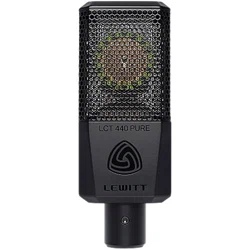Loading ...
Loading ...
Loading ...

4
// How to read a polar pattern diagram
First of all, you have to be able to read a polar pattern diagram properly. It contains
all necessary information you need to foresee the result during recording.
Think of a a 360° eld surrounding the microphone. 0° is the “front” of the
microphone and the angle where the microphone has its maximum sensitivity.
The scale of the circle consists of smaller circles, each representing a 5 dB
decrease in sensitivity.
The decibel (dB) is a logarithmic unit to compare two values. If the specication
of a cardioid pattern microphone states it has a rear rejection of 25 dB, it means
that the most sensitive part (0°) is compared with the least sensitive part (180°).
For (sound) pressure, current and voltage +6 dB is double the signal strength,
+20 dB leads to 10 times the signal. A typical rear rejection for a cardioid pattern
is about -20 dB. Sound coming from the back of the microphone is picked up at
1/10th sensitivity relative to the front signal.
// Cardioid
The most commonly used polar
pattern is most sensitive at 0° and
least sensitive at 180°. You cannot go
wrong using this for most recording
applications. It is easy to get a dry
signal as the cardioid pattern blends
out a bad sounding room, a noisy fan
in the background, etc.
4.2. Phantom power explained
// All condenser microphones require an external power source called “Phantom
Power” to generate polarization voltage for the capsule and to power the circuitry.
Without phantom power, a condenser microphone will not work.
// Phantom power is a DC voltage, that can be supplied by an audio interface,
mixing console, pre-amplier or a designated phantom power supply unit.
// Phantom power needs to be switched on using a designated button located
on the audio interface, preamp, or other recording devices. In most cases,
the designated button reads “P48” or “Phantom Power”.
// Phantom power is always supplied via the connected standard 3-pin XLR cable
and does not require any other connector or cable in addition to that.
// When activating phantom power, a sound can be audible - this is perfectly
normal. You can mute the microphone channel while turning on phantom power
to avoid this sound.
4.3. Polar patterns
It is important to understand the basic principles of polar patterns to get the best out
of every recording. The polar pattern of a microphone determines the sensitivity on
different angles. In other words, it denes how much of the signal will be picked up
by the microphone from different directions. By selecting the right pattern, you can
avoid unwanted sound sources to bleed into your signal, adjust the mix between dry
and room sound or change the frequency response and handling noise sensitivity.
Polar graph frequency
1.000 Hz
0˚
180˚
0
-10
30˚330˚
150˚210˚
60˚
120˚
300˚
240˚
90˚270˚
Figure 4.1
Loading ...
Loading ...
Loading ...
